The tanker is the workhorse of the maritime sector. It was specifically engineered to carry large bulk volumes of liquid cargo over long distances. Because tankers secure the supply of oil and gas to world markets, the majority of the world’s energy-related tonnage is carried by tankers.
Specialised Design Features of Tankers:
Tankers boast several specialized features that enhance their efficiency and safety:
Multiple Compartments: These allow for the simultaneous transport of different liquids, preventing cross-contamination.
Carefully Selected Materials: Nevertheless, the correct selection of materials used for manufacturing tanker tanks is of paramount importance. It involves ensuring that incompatible chemicals do not interact and degrade the material and that the container itself does not contaminate the cargo.
Sophisticated Safety and Pumping Systems: Since the cargo carried by tankers is often very dangerous, nearly all tankers are equipped with very sophisticated safety measures and pumping systems. Each of them is designed for loading and unloading the cargo.
Types of Tankers and Their Roles:
Oil Tankers and Chemical Tankers: Identifiable by their flat decks with a system of cargo and ballast pipelines and vents running along them.
Liquefied Natural Gas (LNG) Carriers and Liquefied Petroleum Gas (LPG) Carriers: Built with specialized features for shipping gas in a liquified state.
The Classification System of Tankers:
The way that tanker vessels are classified means that contract terms can be standardized, freight rates can be agreedupon, and their technical parameters (i.e., can it pass through specific ports or straits) can be defined. The now classic classification system, the Average Freight Rate Assessment (AFRA), which was devised by Royal Dutch Shell in 1954 and is administered by the London Tanker Brokers’ Panel (LTBP), orders tankers into classes based on deadweight tons (DWT), a measure of the cargo-carrying capacity of a merchant ship.
Tanker Sizes and Their Capacities:
Here’s a breakdown of the tanker classifications and their typical cargo capacities:
General Purpose (GP): 10,000 to 25,000 DWT, carrying between 70,000 and 190,000 barrels of motor gasoline.
Medium Range (MR): 25,000 to 45,000 DWT, carrying between 190,000 and 345,000 barrels.
Long Range (LR1 and LR2): 45,000 to 160,000 DWT for both refined products and crude oil, with capacities ranging widely to as high as 615,000 barrels of gasoline or 550,000 barrels of light sweet crude oil.
Aframax: 80,000 to 120,000 DWT, a popular one among the oil companies as they’re frequently of optimal scale.
Very Large Crude Carrier (VLCC): 160,000 to 320,000 DWT. Handles most of the world’s crude oil shipments, including Brent crude from the North Sea.
Ultra-Large Crude Carrier (ULCC): 320,000-500,000 DWT holds the most oil for a tanker at 3.7 million barrels but is restricted to a few ports, such as the Louisiana Offshore Oil Port (LOOP) due to its enormous size.
The Evolution of Tanker Sizes:
As the oil trade grew globally, tankers also grew, summonsing VLCC and ULCC (very large crude carriers) specifications to accommodate larger cargo capacities, which resulted in better economics for shipping crude. This summons is dwelling on the maritime logistics’ constantly dynamism.
The story of tankers – the biggest beasts on the waves – is as large as it is fundamental to the oil industry's global energy distribution. It's not an exaggeration to say that, without the tanker company, liquid cargo could not have been transported worldwide on the industrial scale it is today – a scale without which modern society would look very different. The tanker's history is inextricably tied to the string of innovations that transformed a tiny oil sector into the world's dominant industry.
The Origins of Modern Tankers:
Elizabeth Watts made history in 1861 by taking 224 tons of petroleum to England, the first ship to bring liquid cargo across the ocean. The tanker industry started to organize around 1886 when the first purpose-built oil tankers entered service. They drastically changed maritime logistics.
It is generally seen as the world's first true oil tanker, a 2700-ton vessel built in Britain that carried separate tanks in its hull explicitly built for oil. This addition pioneered the GLUCKAUF—the oil could be pumped into the vessel, making the transfer dramatically safer and more efficient than the barrel-based technique previously used, substantially reducing costs and boosting the amount carried per round trip.
Advancements Through the 20th Century:
Although these early innovations demonstrated the tanker's potential beyond the carriage of oil, the industry's original interest remained relatively unchanged throughout the early- to mid-20th Century. 1950, as the tanker industry continued to refine its designs, vessels with fleet sizes of up to 16,000 DWT (Deadweight Tonnage) entered the tanker scene. Rather than simply functioning as the largest tankers around, the '16,000-ton' vessels were the first class of tankers to separate themselves from the oil trade alone. Until this time, tankers remained dedicated to the carriage of oil – in both a technical sense (their tank compartments retained an oil-like resistance to corrosion) and an economic sense (the most lucrative cargoes on the globe were petroleum products). Only after 1950 did tankers start transporting a broader range of liquid cargoes – most notably chemicals and other substances such as vegetable oil, molasses, and wine products.
After the Second World War, very large crude carriers (VLCCs) and Ultra-large Crude Carriers (ULCCs) were introduced, which could carry thousands of times more barrels of crude oil. In 1990, the industry almost completed the double-hull designs to ensure safety at sea.
Regulatory and Safety Innovations in the 21st Century:
For its part, the IMO has established regulations that limit tanker size and design and minimize the risk of environmental disaster. 'Viewed in this light, the dramatic enlargement of container ships represents a victory of safety and environmental protection over old-school notions of capacity and cost-efficiency.
Oil Tankers:
While oil resources are concentrated in a handful of countries, most nations need their energy, and this transnational demand makes tankers an essential part of modern existence. On the smaller end, product tankers carry refined petroleum products, such as gasoline, naphtha, and diesel fuel, from refineries to seaports. VLCCs (very large crude carriers), on the other hand, ship vast quantities of crude oil from the place of extraction to the refinery.
Product Tankers:
Product tankers can be smaller and trade among west-coast ports or much larger and have a global cross-trade reach. They vary in size and payload, including 'clean' products such as gasoline, diesel, and kerosene, and 'dirty' products such as fuel oils, which are heavier and require heating coils to pump. The former requires more cleaning and sophisticated coatings and segregation systems designed to minimize contamination; dirty tankers, such as those transporting heavier fuel oils, tend to cost less.
Chemical Tanker:
Chemical tankers are purpose-built for the safe and viable transportation of a broad variety of ’special products’ – hazardous and non-hazardous cargoes, such as industrial chemicals (eg, caustic soda and sulfuric acid), edible and in-edible oils (eg, palm and vegetable oil). I help to operate them.
Design and Construction:
Safety and flexibility are key to the design and construction of chemical tankers, many of which have stainless steel or specially coated tanks that enable the carriage of aggressive chemical products while also carrying food products without such products coming into contact.
The multi-purpose nature of chemical tankers is also reflected through their cargo arrangements: Numerous small cargo tanks with dedicated piping systems to different cargo tanks/locations/hold-sections allow the same vessel to carry a broad variety of chemical types at a given voyage, minimising the risk of contamination and ensuring that different chemicals can be loaded, carried, and discharged separately.
Operational Risks and Safety Protocols:
Because their cargo is often hazardous, chemical tankers must be built with the most stringent designs available and operated accordingly. Chemicals can cause incalculable environmental damage, from oil leakage to the potential of hazardous smuggling and risks to human safety.
Essential Operational Procedures for Chemical Tankers:
Planning: All operations on a chemical tanker need to be planned in advance, and the plan needs to be available to personnel both on the tanker and in the terminal. All personnel involved need to have a good picture of the operation details. The plan must be adaptive, allowing changes to be made in consultation in real-time, which in turn needs to be documented as well.
2. Loading Operations:
Initial checks for hose coupling leaks.
Ensuring tank lids are secured, and risers are positioned correctly.
Slow initial loading confirms all connections are secure and prevents static accumulation.
Regular monitoring and adjustments of loading speed to avoid overtopping.
3. Discharging Operations:
Detailed cargo checks, including ullage, density, and temperature at the start.
Maintaining ventilation and safety checks throughout the discharging process.
Careful monitoring of discharge speed, particularly as the tank empties.
Technological Advancements Enhancing Tanker Safety:
The evolution of chemical tanker design mirrors the continuing material development of shipping technology and safety. Double-hull constructions and automated cargo handling are just some of the technologies introduced to minimize the risk in the transport of liquid cargo. External control is supplied through new regulations issued by authorities such as the International Maritime Organization (IMO).
A ship's hull is possibly the most critical feature of a ship's design; indeed, it largely determines how a vessel will look and perform during its operational years. For oil tankers, which are built to transport heavy liquid cargo across oceans, the hull form plays an even more prominent role in defining the overall characteristics of the design. The most significant parameters that affect an oil tanker's hull form are its cargo and capacity.
Weight-Based Design: Maximizing Cargo:
The essential design principle for oil tankers is weight-based, which means that the cargo weight is the crucial element defining a ship's dimensions. For other types of ships, like container ships, the design is often volume-based, and the cargo volume capacity of the spaces determines the ship's dimensions.
Why have a weight-based design instead? Because oil does not spoil (unless stored in a different kind of ship, as it was for the Exxon Valdez), your wait to get back to pick up a second load is determined only by the availability of oil and not by the velocity at which it is consumed; this offers a generation of tankers the luxury of unconcern for speed. Armed with that knowledge, you design to maximize the amount of cargo you can put on board an oil tanker in a single passage.
Hull Form and Buoyancy:
Because the segmental shape gives more space to the cargo oil tanks, oil tankers usually have a full form. Oil tankers, with full-form hulls, have chines, quite a few strips, and the Coefficient of Buoyancy is high compared with finer hull forms in fast ships such as container ships. There are benefits to a full-form hull for oil tankers, not only in terms of capacity but also in terms of stability and buoyancy, which are essential given the heavy and fluid cargo these ships carry.
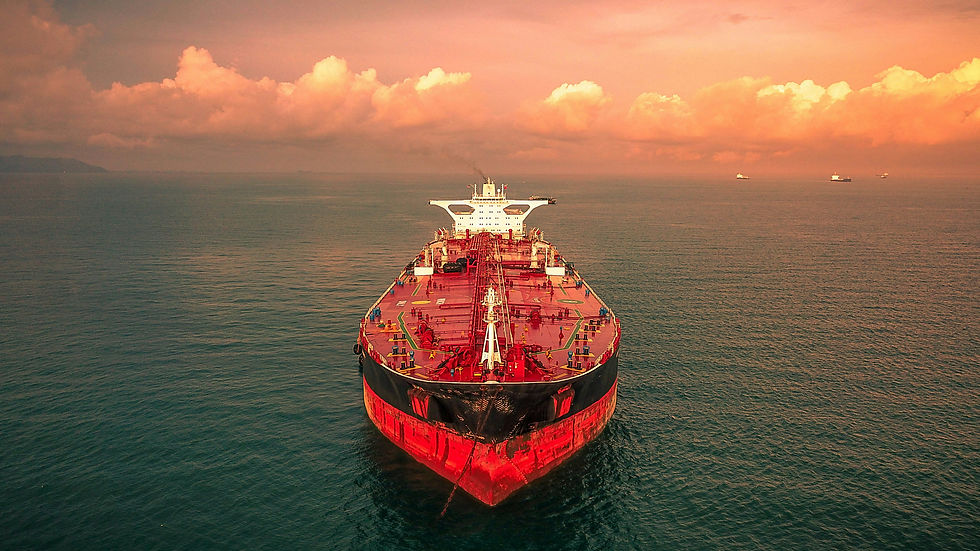
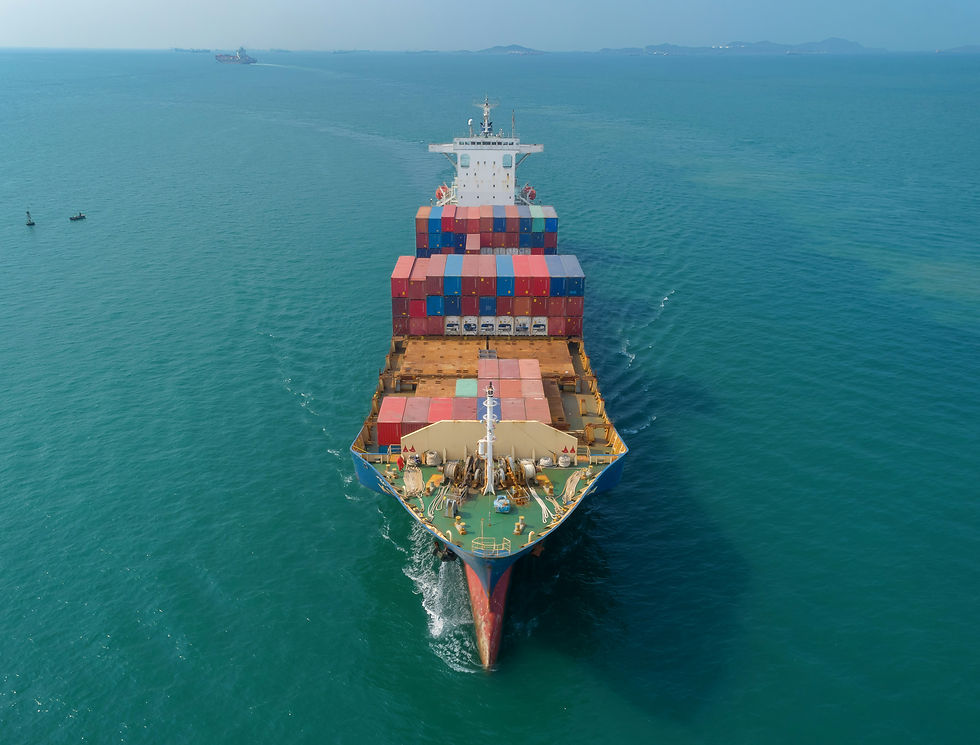
Observe how the fuller shape of the hull forms the bow. See Figure 2, which shows an oil tanker as opposed to a container ship – a ship where cargo capacity is more important than speed. The bluffness of the form to the bow (compared with the fine-hulled form of the Container ship) is not adapted to speed so much as it is at low speeds where cargo capacity tends to be maximized. We have observed already that such a bluff form to the bow gives rise to eddy and wave-breaking at the bow, which gives rise to more wave-breaking and eddy-making resistance.
Operational Considerations:
The hull design also influences the operational speed of oil tankers: if oil is not perishable, it can be transported by ships at a lower operating speed – this is the case with the full-form hull design, which allows increased cargo load weights, given its buoyancy. The main operating characteristics of this vessel are energy efficiency and cost-effectiveness due to the high cargo load at low operating speeds, which is required by the distance between supply centers – a trait typical of oil tankers.
General Arrangement:
Oil tankers are giant cargo ships whose bodies are fashioned for handling trillions of tons of liquid energy shipped by them all over the world. Have a glance at the profile view of this vessel. You can easily get the clue what decorates the body of this ship, which marks its uniqueness in terms of its body structure and its working procedure.
Here are some of the crucial features that make oil tankers a special kind of vessel among all others.
Cargo Oil Tanks and Access:
The Cargo Oil Tanks (COTs) of an oil tanker are one of the most important components of its design. The number of these tanks is usually even. At the start of the design process, they are created to be of similar dimensions based on the total weight of oil that the ship is supposed to contain. Each tank is led to a separate entry. There’s usually a rung ladder for everyone to climb up or a hoistable step that is pulled down for more safety.
Pipeline Network on the Main Deck:
The main deck of a tanker features an unusual arrangement of pipelines. The pipelines are linked to arrangements for loading and unloading cargo oil into and out of the ship. OIl is pumped in and out of the ship using flexible hoses that can be connected to the pipelines, ensuring no oil is spilled during the process.
Deck Cranes and Cargo Handling:
In contrast with bulk carriers, which have deck-mounted cranes for loading and discharging their solid materials cargo, tankers generally have at least one deck crane for operating the heavy cargo oil hoses used in loading or discharging. This crane moves the hoses from their stowage points to the discharge manifolds on the deck to facilitate the oil transfer operations.
Engine Room, Superstructure, and Pump Room:
Traditionally, a tanker’s engine room and superstructure were mounted aft (towards the rear) of the vessel. Still, one of the defining features of the oil tanker is that it has a pump room, usually located just forward of the engine room. All the pumps needed to load and unload cargo oil are installed here. For the tanker system, cargo was something to be shifted below deck through a series of heavily mechanical pumping systems.
The Role of the Bulbous Bow in Enhancing Oil Tanker Efficiency.
The bulbous bow is an essential feature of modern ship design – in particular, a tanker’s bulbous bow can dramatically improve the efficiency of the ship. Even though oil tankers are not particularly fast, adding a bulb reduces wave-making resistance and thereby greatly improves the power efficiency of the ship.

Understanding the Bulbous Bow:
A bulbous bow is an outgrowth of the bow that protrudes in front of the rest of the hull and cuts through the water, reducing drag associated with wave formation. All modern tankers have a bulbous bow, but the shape and geometry of the bulb vary considerably between high-speed vessels and regular tankers.
Types of Bulbous Bows:
Today, there are three standard bulb shapes, with each one designed for different ship types and operational needs:
Delta Type: The lower concentration of volume near the base gives the bulb a rounded bulbous shape overall that is best suited to a ship with frequent changes in the waterline. These typically are vessels operating under heavily fluctuating loading conditions, such as tankers, which often travel loaded and then ballast.
O-Type: The O-type bulb (from ‘round’) has its maximum volume at the center. It is designed for ships that need a cylindrical forebody and cropped stern shape, such as bulk carriers, where balanced volume distribution contributes to good stability and propulsive efficiency.
Nabla Type: Like an upside-down teardrop, a Nabla bulb has more volume accumulated at the top. That makes the Nabla a good option for vessels that have to withstand stormy seas, such as warships. A top-heavy shape improves performance on choppy water.
Bulbous Bow in Tankers:
Tankers, for example, generally carry cargo on only one leg of the entire voyage cycle, returning in ballast, so they would require a bulbous bow that adapts to a range of waterlines. A delta-type bulbous bow is often used on tankers for this reason, and it also works well across the range of conditions. Often, the space inside the bulbous bow is used for ballast to trim the ship. This helps to reduce bow slamming and turbulence in light conditions.
Port structural aspects of oil tankers: Small Coastal/Single Hull Tankers:
Since the structural design of oil tankers varies due to the sheer multifaceted nature of these metal marvels, it is sufficient to look at the midship section more broadly in different types and sizes of oil tankers in order to better understand their engineering wonders. However, we shall focus on the midship section of an oil tanker in a smaller vessel first.
Understanding Small Coastal/Single Hull Tankers:
Most product tankers and coastal tankers, which are relatively small oil tankers, have only a single hull – these don’t have a double bottom, which adds an extra layer between the cargo and the sea for safer shipping in case of a potential breach. However, as stipulated in the International Convention for the Prevention of Pollution from Ships (MARPOL), generally, tankers longer than 120 meters must be double-hulled regardless of the cargo, irrespective of the size to make it more environmentally friendly by reducing the risks of oil spills.
Key Features of Tanker Structural Design:
Trunk Design: Most small tankers will be equipped with a raised structure, a trunk running along the vessel length, accessed by a high ladder. On one side, this structure on top of the deck provides access to cargo oil tanks up to the bottom, and on the other side, it provides additional structural strength.
Framing System: The bottom shell, deck plating, and trunk plating are framed in the longitudinal direction, which increases the longitudinal strength of the ship. On the other hand, side shells are framed only in the direction perpendicular to the longitudinal direction (transversely framed). The stiffeners are placed in the bottom shell, deck plating, and trunk plating every 2.4 meters (see the yellow lines in the figure below) as a precaution against oil pooling in the spaces between the stiffeners and bottom shell, side shell, or deck plating. If pooling occurs, oil-contaminated cargo must be pumped out, which can lead to a chemical attack and speed up the corrosion of the stiffener. Usually, the oil residues in such pockets are too recessed to be reached by the pumping systems.
Stringers And Brackets: A stringer is often attached to the port-side shell to reduce the width of the transverse frames and maximize the adequate cargo oil tank volume. A bracket is another way to ensure the shear stress flows from the port-side shell stiffener to the deck longitudinal and bottom shell longitudinal.
Through-Deck Frames: Straddling spans of three or four frame spaces each, these through-deck frames provide a continuous web that helps stiffen the deck plating, side shell plating, bottom plating, and centreline bulkhead. Horizontal stringers incorporated into these deep webs help reduce their depth, a critical consideration in saving stowage space.
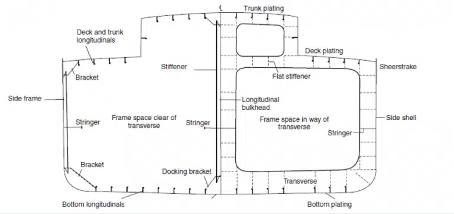
Double Hull Tankers: Enhancing Safety and Environmental Protection in Oil Transportation:
An oil tanker is a type of vessel used to transport oil. The structure of an oil tanker plays an important role in its safety for operation and the environment. There are three kinds of oil tanker designs. Double-hull tankers are known for their better safety features. All oil tankers over 120 meters built have followed this system by the International Convention for the Prevention of Pollution from Ships (MARPOL).
The Design of Double Hull Tankers:
All double-hull tankers—such as Panamax, Aframax, Suezmax, VLCCs (Very Large Crude Carriers), and ULCCs (Ultra Large Crude Carriers)—are fitted with two layers of hull. This is for the sake of security, so that in case of hull rupture, the oil cargo doesn’t come into contact with the outside environment. This arrangement considerably reduces the likelihood of oil spills, an important precaution against marine pollution.
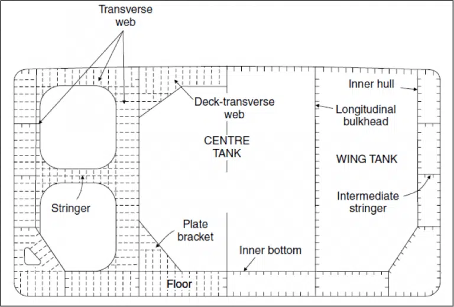
Key Structural Components:
Midship section view: Double hull tanker. Arrangement of main critical components: Outer and inner hull plates are longitudinally framed to maximize strength by resisting shear and minimizing flexing.
Cargo and Ballast Tanks: The central tank of the tanker is used for carrying cargo oil, and the wing tanks, called segregated ballast tanks (SBTs), are used for carrying seawater ballast. The SBTs are coated with epoxy paint and polished in order to prevent corrosion. The reason why the longitudinal stiffeners on the wing tank bulkheads are placed towards the wing tank instead of the central cargo oil tank is to avoid the oil accumulation in the cargo oil tank, which is thought to lead to a drastic decrease in cleaning quality or oil contamination.
Double Bottom Spaces: These are used to carry water ballast. The stiffeners on inner bottom plating are generally directed towards double bottom spaces, safeguarding the cargo tanks from damage.
Transverse and Longitudinal Strength: A transverse web frame is placed deep from the centreline to the shell every three to four frames to provide transverse strength to the vessel. The longitudinal stiffener, pivotal to the ship's structural stability, is welded to such a web frame. Again, the stringer is fixed on such a transverse web for the structural strength of the vessel.
Standardisation and Certification:
Unlike in the past, when the designs of double hull tankers varied among classification societies, today they are harmonised and presented in a standardised way by all societies, irrespective of the society that has originally certified the designs (see design example shown above). The worldwide standard designs are governed by the Harmonised Common Structural Rules (CSR) for Tankers, prepared and published by the International Association of Classification Societies (IACS).
Understanding the Power, Propulsion, and Critical Systems of Oil Tankers:
The biggest ship types in the world, the oil tankers, are designed not only for carrying large cargo but also for efficient and safe sailing away in the sea. This article gives an overview of how tankers are powered and propelled, and a brief description of some basic areas onboard the ship. As the biggest ship type in the world today, an oil tanker is designed in such a way that it can carry a large cargo of thousands of metric tonnes of oil.
Power and Propulsion:
In addition, oil tankers typically operate at relatively low speeds, with a maximum cruising speed of 15.5 knots, so they can use large, slow-speed marine diesel engines. Although these engines take up considerably more space than their high-speed counterparts, they have a very high shaft efficiency and eliminate the losses of a gearbox between the engine and propeller by setting the RPM of the engine equal to that of the propeller. This means they can fit large-diameter, low RPM propellers for maximum propulsive efficiency, ideally suited to the long, transoceanic voyages they routinely make. So efficiency and cost combine perfectly: the cheaper, slower ship makes the longer voyage the most economical (and even beats air travel on some routes).
Essential Onboard Systems:
Tankers designed to transport oil have sophisticated systems intended to maximize the safe operation of their cargo. Here is an outline of the central systems:
Cargo Oil Heating System: In cold weather, the oil that many tankers carry, which is often highly viscous crude oil in tankers, solidifies and clogs the pumps and pipelines when discharge commences, so the vast majority of oil tankers are fitted with a cargo oil heating system to keep the oil at a reasonable temperature to maintain its fluidity and allow safe pumping.
Cargo Tank Venting System: you might have never heard of this system because, as surprising as it sounds, nobody ever sells or ships cargo oil tanks fully filled .There must always be some space because the oil vapors would be highly flammable if contained in a tank. Any vapors that accumulate must be allowed to escape to safety from their enclosed space.
Overflow Control System: This system makes use of level and pressure cascade controls to ensure that the oil level in the individual tanks does not go above its designed limits. Alarms raised by high-level and spill valves are used to signal outliers and take corrective action.
Inert Gas System: To mitigate the potential fire hazard, the space above the cargo oil in the tanks must remain inert. This is accomplished by continuously supplying and regulating inert gases such as argon or carbon dioxide (which replaces oxygen) such that any accumulation of oil vapor cannot ignite.
Fire Fighting System: Since the cargo is inflammable, they need to have a sound fire fighting system compliant with MARPOL regulations. They have fire hoses, extinguisher, and sparkling through the ships, and a button room above the engine room where there are some CO2 bottles; in case of an engine room fire, it will help the men on board to control the situation by CO2 flooding.
Conclusion:
The design and operation of oil tankers are an intricate balance of engineering, environmental stewardship, and navigational ability. The hulls of these giant ships are designed to maximize their cargo-carrying capacity while maintaining their buoyancy; the double hull constructions are an attempt at containment to prevent oil pollution.
The physical structures of these ships include features such as bulbous bows that reduce wave resistance and so increase fuel efficiency (even at pedestrian speeds such as those of very long transoceanic journeys) and power and propulsion systems geared to the particular demands of long transoceanic journeys, such as slow-speed large-bore engines and specialized long-range propeller designs.
Perhaps that is why there are so many systems on board tankers to protect the men's and the environment's safety. Vessels are fitted with the latest high-class cargo oil heating systems, which also take care of the viscosity of the oil, cascade venting systems to safely vent flammable vapors, overflow control systems to prevent oil spills in the sea, inert gas systems to minimize the fire risks, as well as world-class fire-fighting systems, meeting the most stringent international regulations.
With advanced engineering combined with compliances to strict regulatory requirements, oil tanker design is ready to cope with the logistical difficulties of transportation of oil worldwide. Enhancement arising from technology and growing awareness of environmental issues have resulted in fantastic changes in the marine industry. Despite the escalating number of tanker designs, the form may still be considered essential to the world’s future energy supplies.
Suppose we start from the inconvenient truth that oil tankers are complicated engineering marvels capable of demanding feats of precision in their working lives. In that case, this complexity demands that all elements of their design and operation be considered with appropriate attention to detail and innovation. Oil tankers are not omnipresent siphons – they are how a complex set of supply chains and countless streams of personal liberty and comfort continue.
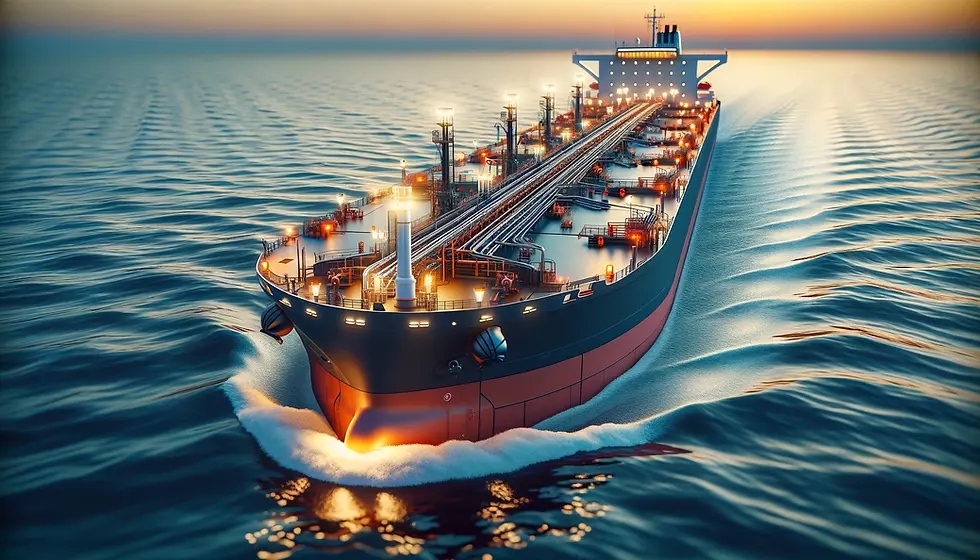
Sources:
Pictures:
https://unsplash.com/de/fotos/rot-weisses-schiff-auf-see-unter-bewolktem-himmel-tagsuber-U9_pRASawlc
https://www.marineinsight.com/naval-architecture/oil-tanker-ships/ https://www.marineinsight.com/naval-architecture/oil-tanker-ships/

Comments